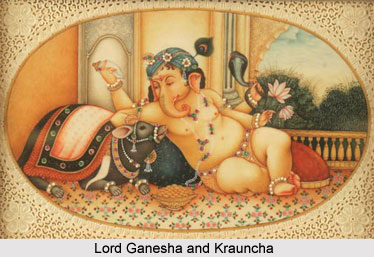 The Legend of Lord Ganesha and Krauncha, the mount rat of the lord, is mentioned in the Ganesha Purana. Lord Ganesha, also known as Ganapati, Vighneshvara, Ekadanta and Vinayaka, is the Remover of Obstacles and the patron of sciences and arts. He is the son of Lord Shiva and Goddess Parvati and the brother of Lord Kartikeya. Ganesha is worshipped before the commencement of any new venture or religious rituals. In the 8 avatars of Lord Ganesha, he is depicted mounting his divine mouse in 5 incarnations. The holy mouse is considered as the main vahana of the deity, who is placed near the feet of Ganesha in most of his idols and sculptures. Moreover, ancient Hindu religious texts like the Brahmananda Purana, Matsya Purana and the Ganesha Purana, mention that the mouse served as the vahana of Lord Ganesha in his final incarnation.
The Legend of Lord Ganesha and Krauncha, the mount rat of the lord, is mentioned in the Ganesha Purana. Lord Ganesha, also known as Ganapati, Vighneshvara, Ekadanta and Vinayaka, is the Remover of Obstacles and the patron of sciences and arts. He is the son of Lord Shiva and Goddess Parvati and the brother of Lord Kartikeya. Ganesha is worshipped before the commencement of any new venture or religious rituals. In the 8 avatars of Lord Ganesha, he is depicted mounting his divine mouse in 5 incarnations. The holy mouse is considered as the main vahana of the deity, who is placed near the feet of Ganesha in most of his idols and sculptures. Moreover, ancient Hindu religious texts like the Brahmananda Purana, Matsya Purana and the Ganesha Purana, mention that the mouse served as the vahana of Lord Ganesha in his final incarnation.
The tale states that Krauncha was actually a Gandharva, a heavenly musician deity. The Upapurana mentions that once a musical function was organized in the court of Lord Indra. Several gods, deities and sages, including Krauncha, were invited to the event. When Indra called Krauncha to come forward, he accidentally stepped on the foot of Sage Vamadeva Muni. Vamadeva and other sages became infuriated at the negligence of Krauncha and cursed him to become a mouse (shrew).
As a result, Krauncha transformed into gigantic mouse and started to destroy everything in his way. The enormous mouse ravaged all the crops and grains, and destroyed all clothes. He also ate all the pages of ancient Hindu scriptures, such as the Puranas and the Vedas. Later he stepped on the ashram of Maharshi Parashar and damaged it. Lord Ganesha resided in that particular ashram at the time. Maharshi Parashar then prayed to Ganesha and asked the lord to save him from the destructions of the mouse. Then Lord Ganesha decided to teach the giant mouse a lesson and thus tied a noose (pasha) on Krauncha. The noose was tied around the mouse and compelled him to fall at the feet of Ganesha. Krauncha bowed to the lord and asked for his forgiveness. The elephant headed deity forgave the enormous mouse and appointed Krauncha as his divine mount or vahana.
But when Lord Ganesha mounted on the mouse, it was unable to tolerate the weight of the lord. Thus, Krauncha prayed to Ganesha to become lighter so that he would be able to support the deity. Lord Ganesha granted his wish and Krauncha has been serving as the divine mount of the lord since then.




















